The Structure and Mechanical Behaviour of Wood (all content)
Note: DoITPoMS Teaching and Learning Packages are intended to be used interactively at a computer! This print-friendly version of the TLP is provided for convenience, but does not display all the content of the TLP. For example, any video clips and answers to questions are missing. The formatting (page breaks, etc) of the printed version is unpredictable and highly dependent on your browser.
Contents
Aims
On completion of this TLP you should:
- Understand the hierarchical structure of wood.
- Be aware of the differences between hardwoods and softwoods.
- Understand how to calculate the stiffness and strength of wood.
- Be aware of water’s effect on wood.
- Be aware of why wood has certain mechanical properties, and how these can be used for a variety of applications.
Before you start
- You should understand the basic mechanics of composite materials.
- You should understand the derivation for the deflection of a beam under symmetrical 3-point bend testing.
- You should understand the derivation for the ultimate tensile stress or strength of a material measured under symmetrical 3-point bend testing.
Introduction
Wood is the oldest and one of the most commonly used engineering materials in the world. The earliest evidence for a domestic structure in Britain was that of a tent-like structure made with wooden supports dating to 7000 BC, and wood is the most commonly used building material to this day. Worldwide, 109 tonnes of wood are used per annum, comparable to the consumption of iron and steel. Wood is so widely used because of its low cost, per tonne 1/60th that of steel, and high specific strength (high value of the merit index s/r). Wood also combines high stiffness and high toughness. As wood is a renewable resource, it is a good material from an environmental perspective and its production requires only a low energy input. One mature tree supplies enough O2 gas for 10 people but we are consuming in the UK 12 trees per person per year. We must therefore think carefully about the environmental impact of using large quantities of wood.
Wood is a fibre-composite material (cellulose fibres in a lignin matrix) with complex overall structure. Wood is a cellular material. Cells form the basic unit of life and are immensely complicated. There are roughly 1012 cells of 4 main types in a tree. Cells display a great deal of self-organisation and assembly. Additionally, the constituents of a tree undergo continuous renewal, making a tree a dynamic system.
In this TLP you will learn how the structure of the tree trunk is specially adapted for its functions: to support the leaf canopy, to transport mineral solutions via conduction, and to store food in the form of carbohydrates. Wood has two types: softwoods and hardwoods. There is however little correlation between the type of wood and its properties: some hardwoods are very soft!
This TLP discusses the mechanical properties of wood, and explains wood’s generally high strength under tension. Wood also shows properties of high toughness and stiffness. These values vary greatly depending on the type of wood and the direction in which the wood is tested, as wood shows a high degree of anisotropy. Wood’s properties are also strongly affected by the amount of water present in the wood. Generally, increasing the water content of wood lowers its strength.
The structure of wood (I)
The basic unit of wood structure is the plant cell, which is the smallest unit of living matter capable of functioning independently. The cell has many functions, such as the manufacture of proteins, polysaccharides and mineral deposits. A plant cell varies in diameter from 10–100 μm. The main difference between the plant and animal cell is that plant cells have a cell wall outside the plasma membrane, which is 0.1 to 100 μm thick. This makes the cells rigid, among other effects prohibiting the locomotion typical of animals. The cell wall supports the cell membrane, as internal pressure in the cell can be as high as 1 MPa. The plasma membrane acts as a selective barrier enabling the cell to concentrate the nutrients it has gathered from its environment while retaining the products synthesized within the cell for its own use. It is also able to excrete any waste products from the cell. The membrane is formed from amphipathic molecules i.e. one end is hydrophilic (water liking) and the other end is hydrophobic (water disliking). The nucleus is the most prominent organelle in cells and contains the genetic information (DNA) necessary for control of cell structure and function. In the cell the endoplasmic reticulum synthesises proteins and the Golgi apparatus sorts them; the proteins are then stored within the fluid cytosol. Chloroplasts contain energy-converting systems that make ATP by capturing and using the energy from sunlight. Mitochondria produce ATP from larger energy-storage molecules, such as glucose. Finally the vacuoles can store nutrients and waste products, increase the cell size if necessary, and control turgor pressure.
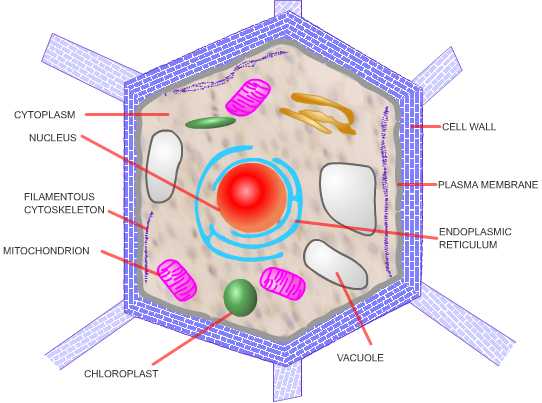
A plant cell
An extracellular matrix called the cell wall, which acts as a supportive framework, surrounds the plant cell. It is made of a network of cellulose microfibrils embedded in a matrix of lignin and hemicellulose, which are examples of polysaccharides. Cellulose is a polymer of 8,000 to 10,000 monomers of anhydroglucose in the form of a flat 6‑membered ring. The individual polymers are aligned in parallel and cellulose is up to 90% crystalline. Cell secretions form the matrix, and cellulose and lignin comprise the bulk of a tree’s biomass.
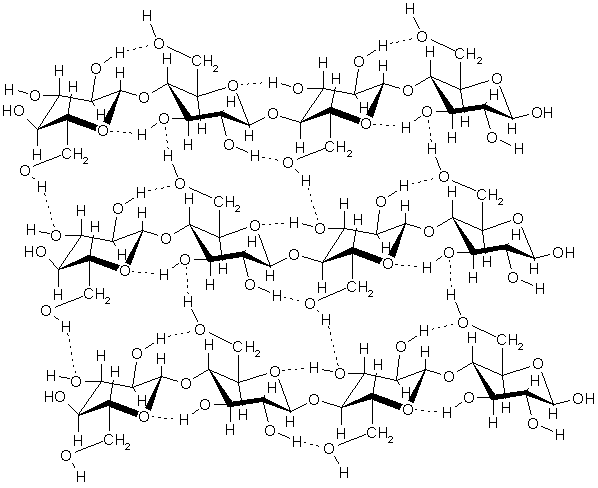
The structure of cellulose
The tubular cell wall has a layered structure:
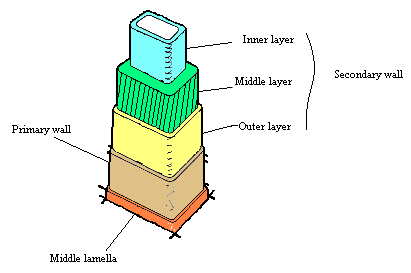
Cell wall schematic
Further cells are aligned parallel to the cell shown. The middle layer is the thickest and most important, and the orientation of the cellulose microfibrils is significant. The orientation of the microfibrils has only been shown for this layer. The cell wall is approximately 50% cellulose fibrils. To toughen the structure, the fibrils are aligned at 10 to 30° to the tree trunk axis in the middle layer of the cell wall.
The open space in dry wood is approximately 50%, but can be as high as 92% in balsa wood. In green wood (freshly cut timber with over 19% moisture content) the amount of open space is less different, as some of the space is filled with water.
The structure of wood (II)
Wood has extreme anisotropy because 90 to 95% of all the cells are elongated and vertical (i.e. aligned parallel to the tree trunk). The remaining 5 to 10% of cells are arranged in radial directions, with no cells at all aligned tangentially. The diagram below shows a cut-through of a tree trunk:
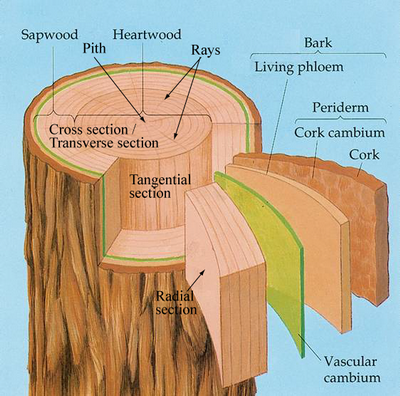
A cut-through of a tree trunk
In the trunk there are three main sections, the heartwood, which is physiologically inactive, the sapwood, where all conduction and storage occurs, and the bark, which protects the interior of the tree trunk. The two main types of tree, softwoods and hardwoods, have distinct internal structures. Coniferous trees are softwoods, with vertical cells, tracheids, 2 to 4 mm long and roughly 30 μm wide. These cells are used for support and conduction; they have an open channel and a thin cell wall:
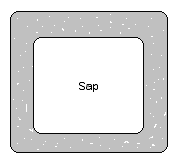
Cross-section of tracheid cell typical of a softwood
The storage cells, parenchyma, are found in the radial direction. Scots pine is an example of a softwood tree. Below is shown a 3D model of the trunk interior of Scots pine made from micrographs of sections cut in the tangential, radial and transverse planes:
Broad-leaved trees are called hardwoods. The vertical cells in hardwoods are mainly fibres, which are 1 to 2 mm long and 15 μm wide. These are thick-walled with a very narrow central channel and are for support only.
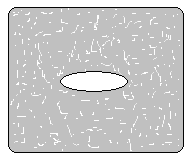
Cross-section of fibre cell found in hardwoods
These cells are unsuitable for conduction, and so the tree needs vessels for this purpose. Vessels are either xylem, which are dead cells that carry water and minerals, or phloem, which are live cells and transport energy sources made by the plant. Vessels are 0.2 to 1.2 mm long, open-ended and are stacked vertically to form tubes of less than 0.5 mm in diameter. Hardwoods also have a small number of tracheid cells, and parenchyma cells are still present radially for storage. Both balsa and greenheart wood are examples of hardwoods. Below is shown a 3D model of the trunk interior of greenheart made from slides taken in the tangential, radial and transverse directions:
The structure of wood (III)
The structure of the tree trunk has now been discussed at both the cellular and macroscopic scale. At the level of the complete structure, there is a further point of interest: the tree is pre-stressed. The centre of tree trunk is in compression, and the outer layers are in tension. The stressing is achieved as the inner sapwood shrinks as it dries and becomes heartwood. As the heartwood has lower moisture content it is better able to resist compression.
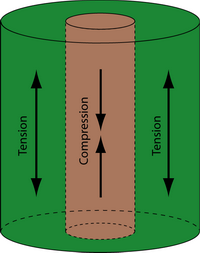
Regions of tree trunk in compression and tension
Try the interactive tree bending demonstration below. Compare the bending of the pre-stressed and not pre-stressed trees in a strong wind, paying attention to the graphs showing the areas of the tree trunk in tension and compression.
When a tree grows, the new cells grow at the edge of the tree from the vascular cambium. At the beginning of the growing season, in spring, the cells that grow are large due to the greater amount of moisture available. Throughout summer, the moisture available decreases and the cells also decrease in size as a result. By winter cells can no longer grow, and cells at the edge of the sapwood region near the central heartwood dry out and die. This sequence is evident as annual growth rings. This process is used to date trees by dendrochronology. In a good growing year, the growth ring will be wider than that in a bad growing year. By working out the sequence of good and bad years it is possible to match this sequence to the tree, as long as it is more than fifty years old when felled, and hence find the age of the tree. Close examination of the last growth ring then pinpoints the actual season that the tree was cut down. This technique was used to date the oldest-known timber track-way in the world, Sweet Track in the Somerset levels, to the winter of 3807 to 3806 BC.
Stiffness of wood
The stiffness of wood can be measured using a simple three-point bend test as shown below:
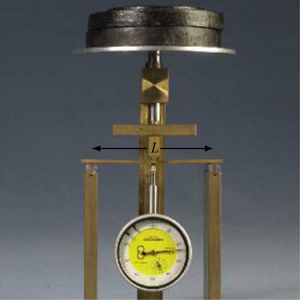
Three-point bend test set-up
The width (w) and height (h) of wood samples are measured, and the specimens are placed in a three-point bend testing apparatus with the height of the wood oriented vertically in the apparatus. The distance (L) between the two supports is also measured. The deflection of the middle of the beam, as a function of load on the pan of the apparatus, is measured to calculate the stiffness. As the elastic properties of wood are being tested it is important to ensure that the sample does not become permanently deformed. To achieve this, the mass on the pan is increased stepwise in 100 g increments, ensuring that the deflection remains less than 3 mm, until a total mass of 600 g is reached. No load is added until the deflection caused by the previous load added has stabilised, and the equipment is not jogged or tapped, as these actions affect the results recorded.
Video of three-point bend test for Scots pine
The resulting load (m) – displacement (d) curves on loading and unloading for (a) balsa, (b) Scots pine and (c) greenheart are shown below:
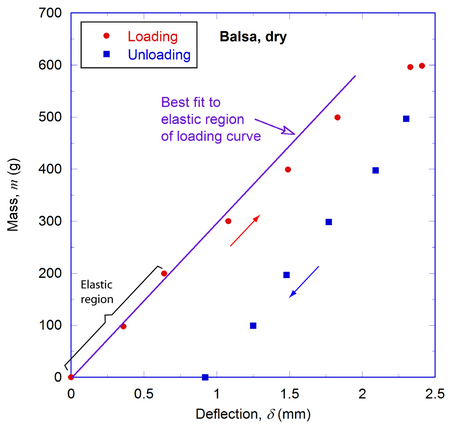 (a)
(a)
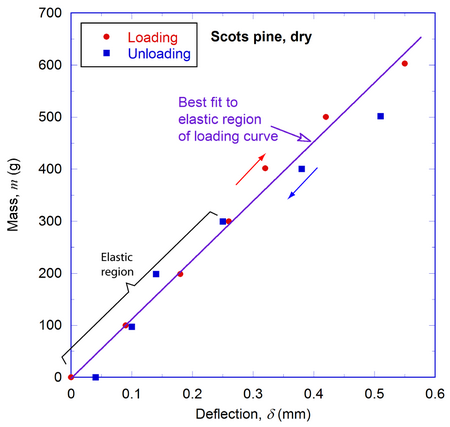 (b)
(b)
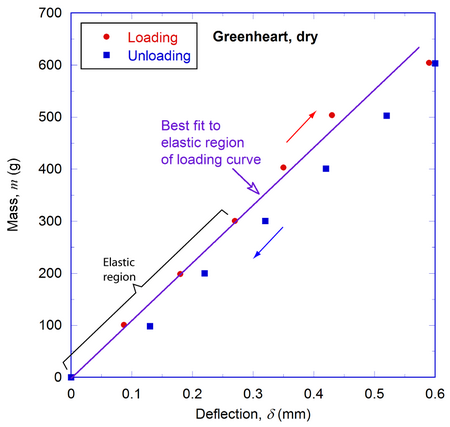 (c)
(c)
Using the equation for the deflection of a material under symmetric three-point bending:
\[\delta = \frac{{mg{L^3}}}{{48EI}}\]
The Young’s modulus for each sample is calculated from:
\[E = \frac{{g{L^3}}}{{48I}}\frac{m}{\delta }\]
Therefore from the graphs, the gradient is \(\frac{m}{\delta }\) and the other values have been measured as in this case \(I = \frac{{w{h^3}}}{{12}}\), so the Young’s modulus can be found. The results for balsa, Scots pine and greenheart are:
Greenheart |
Balsa |
Scots pine |
|
| E (GPa) | 16.4 ± 0.7 |
6.7 ± 0.3 |
13.5 ± 0.7 |
| Textbook values E (GPa) | 21 |
3.2 |
10 |
The textbook values represent a broader range of samples.
Clearly the definition of softwood and hardwood has little relation to the wood’s materials properties: the softwood Scots pine is much stiffer than the hardwood, balsa. This is mainly due to the ultra low density of balsa, as the stiffness (and also strength) of wood correlates with density.
The values of Young’s modulus show that wood is reasonably stiff. Wood is a composite material, and so to stretch the wood samples the cellulose microfibrils in the wood have to be stretched. The Young’s modulus of cellulose fibrils is 100 GPa, and that of lignin and hemicellulose averages to 6 GPa. Under axial loading, an equal strain condition applies and the Young’s modulus of the wood cell wall can be calculated as follows:
E wood cell wall = (1–f) Ecellulose + f Elignin-hemicellulose matrix
= 0.5 (100) + 0.5 (6) = 53 GPa
Clearly, the Young’s modulus of the cell wall is a lot higher than that of wood, as the cells and spaces in the wood filled by air or water also affect wood’s Young’s modulus, decreasing its value. However wood cell wall has measured values of Young’s modulus of 10 to 60 GPa, and so the composite model of the cell wall provides an accurate mechanical description of its behaviour.
The loading and unloading curves do not exactly coincide. This demonstrates that wood shows viscoelastic properties under deformation. Viscoelasticity is advantageous, not least because it dampens vibrations: in high winds damping of resonance protects the branches and trunk from excessive deflections associated with damage. A stiff material could also limit deflections, but at the expense of high stresses. Overall, it is preferable to be able to bend. The origins of wood’s viscoelastic behaviour lie in the lignin matrix. Lignin is an amorphous polymer, and its elastic regions respond instantly to the strain while the viscous regions respond more slowly. Due to this viscoelasticity, energy is dissipated in the wood on loading. On the graphs the area between the loading and unloading curves shows the elastic strain energy that is being stored in the wood. However the amount of energy is not high enough to cause problems. In living trees, in particular, the high water content of the wood inside the cells and extracellular matrix restricts a significant temperature rise, because of the high heat capacity of water.
Strength of wood
The strength of wood can also be measured using a three-point bend test. The width (w) and height (h) of wood samples are measured, and the specimens are placed in the three-point bend testing apparatus with the height of the wood orientated vertically in the apparatus. The distance (L) between the two supports is also measured. The wood samples are again loaded in 100 g increments. If the micrometer needle continues to move after a 100 g load has been added to the pan, the reading is allowed to stabilise before further mass is added. The mass on the pan is increased in this way until the sample fails. At this point the load and deflection of the sample before failure are noted.
Video of three-point bend test of greenheart
By following this method and repeating for three samples of balsa, Scots pine and greenheart the following results were obtained:
Wood tested |
Greenheart |
Scots pine |
Balsa |
||||||
1 |
2 |
3 |
1 |
2 |
3 |
1 |
2 |
3 |
|
w (mm) |
3.0 |
3.4 |
3.0 |
3.4 |
3.1 |
3.6 |
3.8 |
3.7 |
3.7 |
h (mm) |
3.1 |
3.6 |
3.4 |
3.6 |
3.4 |
3.4 |
3.7 |
3.6 |
3.6 |
L (mm) |
90 |
||||||||
Maximum mass (kg) |
4.7 |
7.9 |
5.8 |
2.9 |
3.3 |
3.0 |
2.5 |
0.8 |
1.0 |
Maximum deflection (mm) |
6.05 |
5.75 |
6.80 |
3.59 |
6.06 |
4.60 |
2.50 |
4.10 |
4.00 |
Strength (MPa) |
215.9 |
237.4 |
221.5 |
87.2 |
120.4 |
95.5 |
63.6 |
22.1 |
27.6 |
Average strength (MPa) |
225 |
101 |
38 |
||||||
The error in the individual strength results can be calculated using the standard deviation in the strength measurements. The error in the average value of strength is then found by dividing this error by ![]() , where N is the number of strength measurements taken.
, where N is the number of strength measurements taken.
The errors in measurements are:
|
Greenheart |
Scots pine |
Balsa |
Standard deviation (MPa) |
11.2 |
17.3 |
22.6 |
Error in average strength (MPa) |
6.5 |
10.0 |
13.0 |
To calculate the strength the following equation is used:
Strength = \(\frac{{3mgL}}{{2w{h^2}}}\)
The results for balsa, Scots pine and greenheart are as follows:
|
Greenheart |
Scots pine |
Balsa |
Strength (MPa) |
225±7 |
101±10 |
38±13 |
Textbook values (MPa) |
181 |
90 |
23 |
The textbook values reflect a wider range of samples. The large differences between our experimental results and the textbook values can also reflect errors in the weights, distance between the supports, and w and h. Three-point bending is not a very accurate method for strength testing, as the force is concentrated at one point in the material. The high error also shows the natural variability of wood within a species, and even within a tree.
Wood performs well under uniaxial tension, due to the high strength of the cellulose microfibrils. Wood is a lot weaker in compression, as the cells can collapse. Buckling of the cell walls occurs first in the vertical cells at the point where they are deflected by the rays (radial cells). This leads to creases, which can act as cracks in the wood when tension is applied. For this reason, diving boards break if turned over. The unseen crease that was in compression on the underside of the board is put in tension when turned over, causing the board to fail. On bending of wood, gradual crushing occurs on the compression side of the beam, transferring load to the tension side (lower side in our three-point bend tests). Trees have evolved to avoid this problem by being in a pre-stressed state. As the outer layers of the tree trunk are in tension normally, on bending the compressive side of the trunk can avoid going into an absolute state of compression.
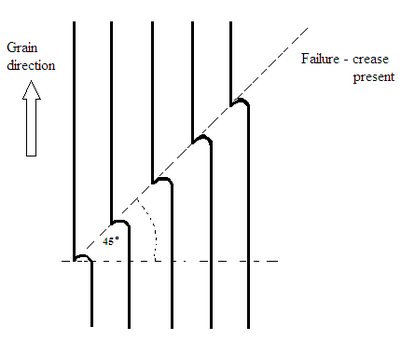
Compressive failure in wood
The wood samples fail by crack propagation across the lower surface of the samples, which are under tension. A simple way of explaining the high failure stress (strength) of wood is to say a fibre pull-out mechanism occurs on failure. As it is the fibres that must be broken for the sample to fail, the strength of the sample depends mostly on the strength of the fibres within the wood. Cellulose fibres are quite strong, so wood also has reasonable strength, and very high specific strength due to its low density. However, as we will see later, the fibre pull-out mechanism cannot completely explain the high strength of wood.
Water's effect on the mechanical behaviour of wood
The mass of water in a freshly felled tree is 60 to 200% of the dry mass of the tree. In dried out timber there is only roughly 10 weight percent water content. However timbers tend to achieve equilibrium with the surrounding air, settling to a moisture content of 22 to 23% in moist, water-saturated air. The effect of water on wood must therefore be considered. Combining and repeating the previous two experiments with the three-point bending equipment can help to demonstrate the effect. Some wood samples are soaked in water for 24 hours. This should ensure that they have a similar level of water content as green (newly felled) timber. The deflections of the wood samples are noted as the mass on the pan is increased in 100 g increments up to 600 g in order to calculate the Young’s modulus of the wood. The mass is then increased further until the failure load is reached. At this point the failure load and maximum displacement of the beam centre are noted. This should allow a measurement of the strength of the wet wood samples.
Video clip showing a three-point bend test to measure the deflection and failure load of a wet balsa sample
The stiffness and strength of the wet samples are worked out using the methods shown previously. By following this method and repeating for three samples of balsa, Scots pine and greenheart the following results were obtained:
|
Greenheart |
Scots pine |
Balsa |
Stiffness (GPa) |
16.1±1.7 |
6.0±0.7 |
2.2±0.7 |
Strength (MPa) |
112±3 |
47±4 |
11±3 |
Evidently increasing the water content of wood by soaking wood samples in this way lowers the stiffness and strength of the wood. When dry timber has its water content increased to the levels found in green timber, the cell walls fill with water. This causes the cell walls to expand and a dimensional change occurs. Water’s presence dramatically softens the cell walls. The hydrogen bonds between different polymer chains in the crystalline cellulose microfibrils can break. Hydrogen bonds form with water instead, as it is a small, polar molecule and so can get in between the polymer chains. Stronger hydrogen bonds are formed between cellulose and water than between cellulose and cellulose, making hydrogen bonding with water more favourable. This softens the cellulose microfibrils as they are no longer so strongly bonded to each other, making it easier to untangle and hence stretch the fibres. This leads to a decrease in the stiffness of wood.
As water is expanding the cell wall, there are also fewer cellulose microfibrils per unit area. Hence the strength of the wood decreases as, for a given applied stress, the load per fibre is greater. This makes the fibres more likely to break, leading to a crack in the wood sample, causing earlier sample failure.
The graph below shows how the compressive strength of a sample of Scots pine changes as the water content increases. Under compression, there is a very marked weakening effect as water reduces the bonding between fibres, making cell walls easier to buckle.
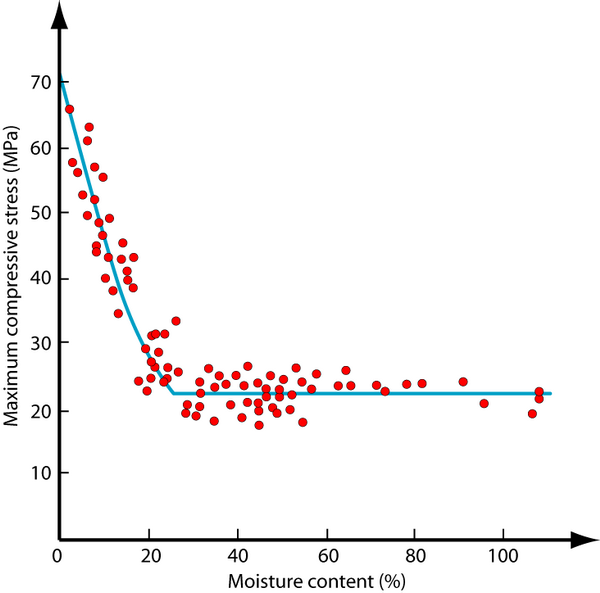
Longitudinal compressive strength of timber as a function of its moisture content [1].
Wood as an engineering material
Wood has many advantages as an engineering material. For example, its high toughness is due to the cellulose microfibrils present in a matrix of lignin and hemicellulose. As wood is a fibre composite, its toughness can be analysed in terms of a fibre pull-out mechanism of failure. For a typical commercial wood a fibre pull-out mechanism of failure would predict a value of Gc (toughness) of 1.5 kJ m-2, whereas in fact the measured value is 15 kJ m-2. The extra toughening is due to the helical winding of cellulose microfibrils in the cell wall, offset at 10 to 30° to the trunk axis. Because of this offset, the axial modulus of the wood is decreased but there is a great increase in toughness. On failure, the middle layer of the cell wall parallel to the fibrils cracks first. This leads to a decrease in the diameter of the layer, causing it to separate from the outer layer of cell wall and fold inwards. An enormous absorption of energy results, leading to wood’s high toughness. On bending, splitting also occurs parallel to the grain and ahead of the crack, blunting the crack. High toughness is therefore imparted to the wood as it reduces the force concentration at the tip of the crack. The progression of the crack may be stopped or at least slowed down, increasing the amount of work needed to reach breaking point.
Other advantages of using wood as an engineering material include:
- the low energy content needed for production,
- the low cost of production,
- wood is an environmentally friendly material,
- wood is a renewable material. When trees grown in sustainable forests are cut down, more trees are planted, keeping the trees from extinction and maintaining the levels of oxygen production by living trees.
- wood has a very high specific strength due to its low density and reasonable strength,
- wood’s low density also makes it easier to transport,
- there are very low costs associated with the disposal of wood,
- wood is not electrically conductive,
- most woods are non-toxic,
- wood is low in thermal conductivity,
- nails and screws do not measurably weaken wood, if put in with care, showing that wood is very resistant to stress concentrations.
However wood also has disadvantages as an engineering material which generally stop its use as a high-tech material. These include:
- there is large variability in properties between species and, depending on growing conditions and the position of the wood within a trunk, within a species.
- wood is dimensionally unstable, as water changes its dimensions.
- wood’s strength decreases when wet.
- time-dependent deformation such as creep and viscoelasticity occur in wood. Creep of wood makes it important that longbows or violins are not left tightly strung. Creep occurs due to movement of the non-crystalline (amorphous) sections of the cellulose microfibrils.
- wood is highly combustible.
- wood is susceptible to termites, woodworm and infestations.
- wood can’t be used at high temperatures.
- wood is susceptible to rot and disease.
- wood is highly anisotropic, although this can be limited by the use of plywood. Plywood involves assembling layers of wood with orthogonal grain orientation, decreasing the anisotropy.
Despite these disadvantages wood is the most commonly used building material in the world. It is used to make houses, furniture, cricket bats, longbows and was in the past used for wheel rims and hubs, among much else.

Longbow
In longbows yew wood is commonly used. Yew was used to make bows as long ago as 3500 BC, from which time a bow was found in the Somerset Levels. Such bows could shoot an arrow over a hundred metres. Medieval longbows, such as those used by the English against the French at the Battle of Agincourt in 1415, could shoot effectively as far as 220 m. The longbow was used by the English in battle for roughly 400 years, being treated until 1662 AD as a military weapon. The bow was also a successful hunting weapon. Yew wood is hard, dense and finely grained. A region of the tree bordering both the sapwood and heartwood regions is used to make the bows. The sapwood can withstand the tension produced on drawing the arrow and so acts as a backing to the bow. On the other hand, the heartwood will endure the compression occurring on the inner edge of the bow.

Roof trusses
Wood is also generally used to make trusses on which to build house roofs, still used today in most houses, as other alternatives, such as steel, are too expensive. For this application, the primary consideration is cost, with the wood needing to be cheap as reasonably large quantities are used. It is also useful to choose a wood that will not easily succumb to rot, disease or infestation. The wood must be strong in order to carry the weight of the roof and allow trusses that span greater distances. However, it must also be light for easy transport and manufacture of the roof, and so that no unnecessary weight is placed on the walls of the house. Spruce and pinewoods are often used as they are easy and quick to grow, and hence cheap. They can adapt to a wide variety of growth conditions and are widespread in North America and Europe, making them widely available.
Summary
In this TLP the structure of wood has been studied. You will have learnt that hardwoods contain vessels and fibres whereas softwoods do not. All trees are pre-stressed, and how and why this occurs has been discussed.
You should be aware of how the strength and stiffness of different types of wood can be calculated. You will have seen that different woods have different properties, but that it is possible to understand their general behaviour using composite material models.
Wood shows viscoelasticity and has different properties when wet. You should now be aware why these properties occur, and how they affect the material. You should also understand why wood is commonly used as an engineering material, and the disadvantages of its use for particular applications.
Questions
Quick questions
You should be able to answer these questions without too much difficulty after studying this TLP. If not, then you should go through it again!
-
What is the main difference between hardwoods and softwoods?
-
How do wood's materials properties change when wet?
-
What deformation characteristic does wood show on three-point bend testing?
-
By what mechanism does wood fail on loading during three-point bend testing?
-
Which of the following is not present in a plant cell?
-
Which region of the yew tree is used to make longbows?
Deeper questions
The following questions require some thought and reaching the answer may require you to think beyond the contents of this TLP.
-
Below is shown a 3D model of the trunk interior of balsa made from slides taken in the tangential, radial and transverse directions. Identify the key features on this 3D balsa wood sample:
-
Calculate the percentage of elastic strain energy that is stored in a loading-unloading cycle for a wood sample.
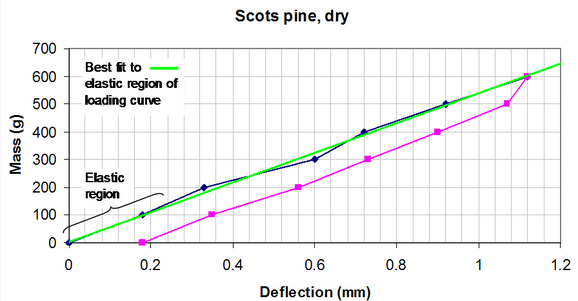
-
Calculate the stiffness of this wood sample given the previous graph of loading and unloading for Scots pine.
-
(…continued from previous question) Now calculate the strength of the wood sample using the following results:
L (cm)
9.0 ± 0.1
w (mm)
3.20
h (mm)
3.30
mass (kg)
1.7 ± 0.05
Use g = 9.81 m s-2
-
(...continued from previous question) What are the errors in your calculated values of stiffness and strength?
-
What wood, out of the following, would be used to make a cricket bat blade?
a Willow: Tough, light and resilient
b Cane: Light and springy.
c Birch: Inexpensive, tough and heavy.
d Elm: Very easy to bend, good durability and easy to work.
Going further
Books:
- Steven Vogel, Comparative Biomechanics, Princeton University Press, 2003.
- J.E. Gordon, Structures: Or Why Things Don’t Fall Down, Penguin Books, 1978.
- J.E. Gordon, The New Science of Strong Materials: Or Why You Don’t Fall Through the Floor, Penguin Books, 1968.
Papers:
[1] J.M. Dinwoodie, Timber – A Review of the Structure-Mechanical Property Relationship, Journal of Microscopy, vol.104, pt.1, May 1975, pp.3-32.
Websites:
- Greenheart
Website describing the explosive properties of greenheart.
- Balsa
Website describing a brief history of Balsa and its use.
- Mosquito aeroplane
Website describing the history of the Mosquito wooden aeroplane.
- Plywood
Use of plywood in plane construction.
- Archery
Short history of archery.
- Dendrochronology
Brief explanation of dendrochronology and its uses.
- Cricket bats
How cricket bats are made.
Academic consultant: Lindsay Greer (University of Cambridge)
Content development: Sonya Pemberton
Web development: Jin Chong Tan
This DoITPoMS TLP was funded by the UK Centre for Materials Education and the Department of Materials Science and Metallurgy, University of Cambridge.

